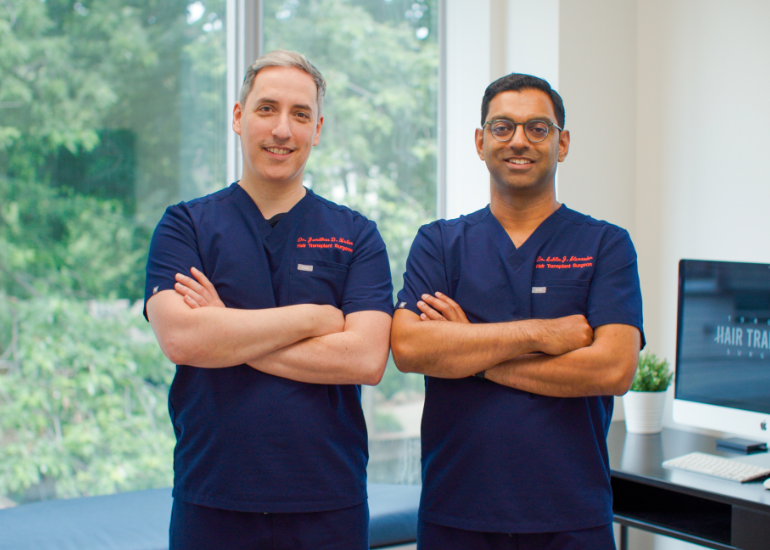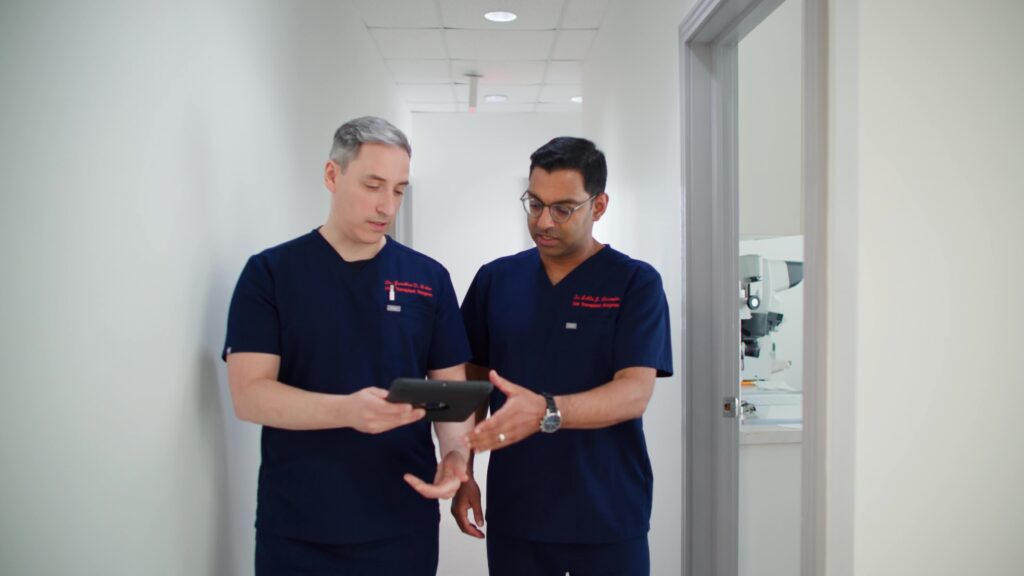Complete Guide to Choosing the Best Hair Transplant Surgeon in Toronto
Dr. Jonathan Huber and Dr. Ashlin Alexander are dedicated to providing all their patients with truly aesthetic and natural-appearing results. Though their practice is based in the greater Toronto area, they have helped patients from as far away as Africa and Asia regrow their hair with innovative techniques and proven technologies.

- Home
- Hair Restoration
- Complete Guide To Choosing The Best Hair Transplant Surgeon In Toronto

Toronto Hair Transplant Surgeons are internationally known for our pioneering work in hair transplantation.

Best Hair Transplant Toronto: Guide to Choose Your Doctor | Hair Grafting Surgery
Introduction to Hair Transplantation
Hair transplantation is a specialized surgical procedure designed to address thinning hair and restore a natural looking hairline. This process involves relocating healthy hair follicles from a donor area—typically the back or sides of the scalp—to areas experiencing hair loss. The goal is to achieve results that blend seamlessly with your existing hair, creating a completely natural appearance.
There are two primary methods used in hair transplantation: Follicular Unit Extraction (FUE) and Follicular Unit Transplantation (FUT). FUE, also known as follicular unit extraction FUE, is a minimally invasive technique where individual hair follicles are carefully extracted and then implanted into the balding or thinning areas. This method leaves minimal scarring and allows for a quicker recovery. FUT, on the other hand, involves removing a thin strip of hair from the donor area and dissecting it into individual follicular units for transplantation. FUT allows for the transplantation of a larger number of grafts in a single session, making it suitable for extensive areas of hair loss. Both techniques are highly effective, and the choice between them depends on your unique needs and goals. No matter the method, the focus is always on achieving a natural looking hairline and restoring confidence.
Understanding Hair Loss
Hair loss, or alopecia, is a widespread concern that affects millions of people around the world. It can occur for a variety of reasons, including genetics, hormonal changes, certain medical conditions, and the natural aging process. The most common type of hair loss is androgenic alopecia, also known as male or female pattern baldness, which is primarily driven by hereditary factors and hormones.
Other forms of hair loss include conditions like alopecia areata, an autoimmune disorder that causes patchy hair loss, and telogen effluvium, which leads to excessive shedding due to stress or other triggers. Understanding the underlying cause of your hair loss is essential in determining the most effective treatment plan and setting realistic expectations for hair restoration.
Hair Loss Treatment Options
When it comes to treating hair loss, there are a variety of options available to help you regain a fuller, more youthful head of hair. Medical treatments such as minoxidil and finasteride are commonly prescribed to slow down or halt hair loss, and can be effective for many individuals. For those seeking a more permanent solution, hair transplantation offers the opportunity to restore a natural looking hairline and improve overall hair density. Natural-looking hair restoration can restore confidence and a youthful look for patients.
In addition to surgical procedures, alternative therapies like platelet rich plasma (PRP) therapy and low-level laser therapy (LLLT) are gaining popularity for their ability to stimulate hair growth and support the health of existing hair. Each treatment option has its own benefits, and the best approach to treat hair loss will depend on your specific needs, the extent of your hair loss, and your desired results.
Hair Transplant Surgery: What to Expect
Undergoing hair transplant surgery is a significant step in your hair restoration journey, and understanding what to expect can help you feel more confident throughout the process. The first stage is the initial consultation, where your hair transplant surgeon will assess your hair loss, review your medical history, and discuss your goals for the procedure. A comprehensive evaluation of your medical history and current medications will be conducted during the consultation process. This personalized approach ensures that your treatment plan is tailored to your unique needs.
On the day of the surgical procedure, the surgeon will carefully extract healthy hair follicles from the donor area—usually the back or sides of your scalp—and transplant them to the areas affected by hair loss. The entire process is performed with precision to ensure natural looking results and minimal discomfort. After your hair transplant surgery, you will receive detailed post-operative instructions to promote healing and optimize the growth of your new hair. Following these guidelines is essential for achieving the best possible outcome.
Complete Guide to Choosing the Best Hair Transplant Surgeon in Toronto
Dr. Jonathan Huber and Dr. Ashlin Alexander are dedicated to providing all their patients with truly aesthetic and natural-appearing results. Recognized as a leading hair transplant centre in Toronto, the clinic is known for providing the best hair restoration and hair transplants Toronto has to offer. Their expertise in hair transplant Toronto and their reputation for excellence in hair Toronto make them a top choice for those seeking advanced solutions. Toronto Hair Transplant Surgeons Toronto has been awarded ‘Best hair restoration in Toronto’ seven times in a row by Consumer’s Choice. Though the practice is based just outside of Toronto, they have helped patients from as far away as Africa and Asia regrow their hair with innovative techniques and proven technologies, earning awards and recognition in transplant Toronto.
Here are the Toronto Hair Transplant Surgeon’s top tips for choosing the best person to perform your hair transplant surgery
1. DO YOUR HOMEWORK TO FIND THE RIGHT SURGEON AND TEAM.
Your experience with the hair surgeon and his or her staff is by far the most important consideration for anyone considering a hair transplant procedure. Due diligence on your part is essential. Just as you wouldn’t hire an unlicensed home contractor to upgrade your house, you should make sure any surgeon you are considering is highly qualified to perform your hair transplant. Ask about the doctor’s credentials, such as their affiliation with a respected professional organization such as the College of Physicians and Surgeons of Ontario, a peer-reviewed process that attests to their high level of skill and ethical practice. Dermatologists are medical doctors who specialize in diagnosing and treating hair loss, including performing procedures like FUE hair transplants. Some surgeons are also facial plastic and neck surgeon specialists, bringing additional expertise to surgical hair restoration. They are each 100% focused on hair restoration in our clinic and Surgeons of Ontario and the International Society of Hair Restoration Surgery (ISHRS).
The ISHRS is a highly select body featuring the world’s leading hair transplant surgeons, and only those whose peers hold them in high regard get invited to join. To maintain this status, a surgeon must continue to meet established educational criteria over time, such as serving in leadership positions, publishing scientific papers and teaching at scientific programs.
It is not just the surgeon who is important, but the team behind them. Make sure the doctor’s staff is friendly and approachable, and that they have a patient-first mentality that makes you feel like a valued client from the moment you reach out to schedule your consultation.
2. ASK TO TOUR THE SURGICAL FACILITY.
All hair transplant patients should expect the very highest standards of care, safety and cleanliness at their chosen clinic. Ask about the facility and request a tour. Does the equipment look modern and advanced? Leading clinics utilize the latest hair transplant technology to ensure optimal results and patient safety. What steps will the doctor and his team take to ensure your comfort and safety during the procedure?
3. WILL YOU BE ABLE TO HAVE A PRIVATE 1:1 CONSULTATION?
Any trustworthy hair transplant surgeon will insist on doing a personal consultation with all potential patients before undergoing a procedure. A hair restoration consultation is a crucial step to assess your individual needs and develop a personalized treatment plan. During this consultation, the surgeon will evaluate your degree of hair loss and discuss your expectations and desired hair coverage. The goal of this meeting will be to assess whether it is possible to achieve your desired results.
Be wary of any hair transplantation clinic where a salesperson is your first point of contact. At the Toronto Hair Transplant Surgeons, virtual consultations are available to all potential patients who are deciding whether to go through with a hair transplant procedure. Virtual consults with each patient are the only way our doctors can fully evaluate your hair loss and give you a realistic idea of what outcomes you can expect from your hair restoration surgery.
4. EXPERIENCE IS PARAMOUNT.
There are different approaches to hair transplantation, and not all hair transplant professionals specialize in the same techniques. If your surgeon is not a full-time specialist in hair restoration, be sure to ask what percentage of his/her practice is dedicated to the procedure.
The most cutting-edge hair transplant procedure is follicular unit excision or FUE. With this method, the surgeon removes individual donor grafts in small groups and then implants them into the balding areas. FUE has become the world’s leading method of hair transplantation because, unlike older approaches, it does not require a lengthy incision resulting in a linear scar. When an experienced medical professional performs FUE, the results look totally natural. Our clinic is recognized for its expertise in fue hair transplants, offering patients the advantages of the fue hair transplant technique, such as minimal scarring, natural results, and suitability for various hair loss conditions.
Having personally trained with the pioneer doctor in larger hair transplants and shared those perfected methods with Dr. Huber, and the addition of their new partner Dr. Alexander regularly performs large-scale FUE cases in a single day.
- We are one of the only clinics in North America where the surgeon harvests every graft and makes every site for planting.
- We have 38 + years of experience.
- We were one of the first clinics in the world to perform FUE in 2002.
- We were the first clinic worldwide to perform large session FUE in 2004.
- We have harvested over 10+ million grafts, demonstrating our extensive experience with grafts transplanted and our expertise in handling hair grafts using advanced surgical techniques.
The number of grafts required for a hair transplant depends on the extent of hair loss, the size of the treatment area, and the desired density to achieve natural-looking results.
Having said the above – it is also important to note, that an experienced hair surgeon will also be able to advise you on what method (FUE or FUT) of a hair transplant will be most beneficial FOR YOU. A lot of factors influence whether you are an ideal candidate for a particular method or not. Don’t be oversold on the latest and greatest if it’s not the right solution for you! Keep in mind that further hair loss may require additional procedures or ongoing care to maintain your results.
5. REVIEW PATIENT TESTIMONIALS.
Any reputable hair transplant surgeon will be happy to share recent patient testimonials with potential clients, which is why many of the best surgeons make testimonials a prominent part of their website. When reading testimonials, the most important thing to look for is people who say they are happy with their outcomes and the level of care they received.
6. REQUEST TO SEE BEFORE-AND-AFTER PICTURES.
In addition to reading testimonials, you should also look at pictures – after all, as the saying goes, a picture is worth a thousand words. Looking through before-and-after photos of former patients is the best way to determine a doctor’s level of skill and get a sense of the results you can expect to achieve from your surgery. In particular, look for photos of patients who have a similar degree of hair loss as what you are experiencing. Pay close attention to how well the transplanted hairs blend with the patient’s natural hair, and whether the results show a natural hairline that seamlessly matches the existing hair. The placement of individual hairs is crucial for achieving a natural, undetectable appearance and restoring confidence.
Don’t forget, it takes up to a year for transplanted hair to grow in fully, so don’t be alarmed if you have hair surgery and don’t immediately see a full head of hair growing in.
7. ASK ABOUT PRICING.
When you see a hair transplantation doctor advertising claims or prices that seem too good to be true, that’s probably because they are. If you find a doctor or hair transplant clinic that says they offer “discount pricing,” make sure you research their credentials and what procedure or technique they perform.
Unfortunately, the hair transplant industry is rife with scams and misinformation, and there are some unscrupulous people who claim to be hair transplant specialists, but who are not medical professionals. Do your research to ensure you are getting the best and most reliable hair transplant procedure available.
The two main costs of a hair transplant are the surgeon’s time and clinic/hospital fees. Low prices could be a red flag of inexperienced or unqualified surgeons and ill-equipped or sometimes unhygienic facilities. When it comes to the satisfaction you’ll get from your hair transplant surgery, it really is true that you get what you pay for.
For more details about pricing, procedures, and what to expect, patients should review the hair transplant FAQs.
8. WILL YOU RECEIVE CARE AFTER THE PROCEDURE?
All reputable hair transplant providers focus not just on the procedure itself, but on providing comprehensive aftercare. A true commitment to patient care means following up after the surgery to ensure all patients are 100% satisfied with their results.
At the Toronto Hair Transplant Surgeons, we are committed to being not just the best hair transplant clinic in the Toronto area, but the preeminent hair transplant provider in the world. Our doctors are skilled and experienced surgeons who handle all consultations and perform all procedures themselves.
Hair Growth and Advanced Techniques
After a hair transplant procedure, patience is key as your transplanted hair gradually begins to grow. Most patients start to notice new hair growth within three to four months, with continued improvement in hair density and thickness over the following year. The full effect of a hair transplant, whether FUE or FUT, is generally realized 12 to 18 months after the procedure. The final results are typically seen after 12 to 18 months, revealing a fuller, more natural head of hair.
Advanced techniques such as FUE and FUT have revolutionized the field of hair restoration, offering minimally invasive options with natural looking results. In addition to these methods, innovative therapies like platelet rich plasma (PRP) and low-level laser therapy (LLLT) can further enhance hair growth and improve the health of both transplanted and existing hair. Many leading hair transplant clinics also provide specialized procedures, including eyebrow transplants and facial hair transplants, to help patients achieve their desired look. With these advanced techniques, restoring hair and confidence has never been more achievable.


